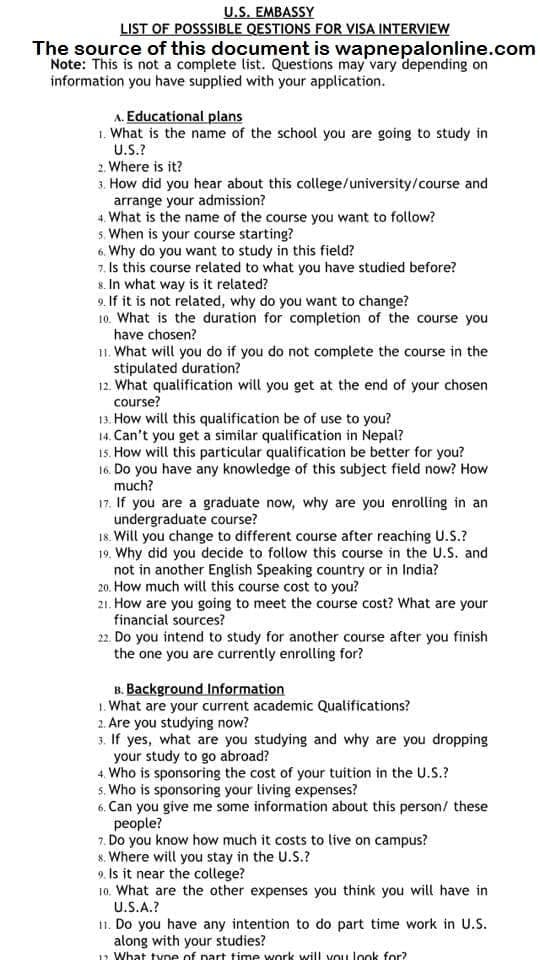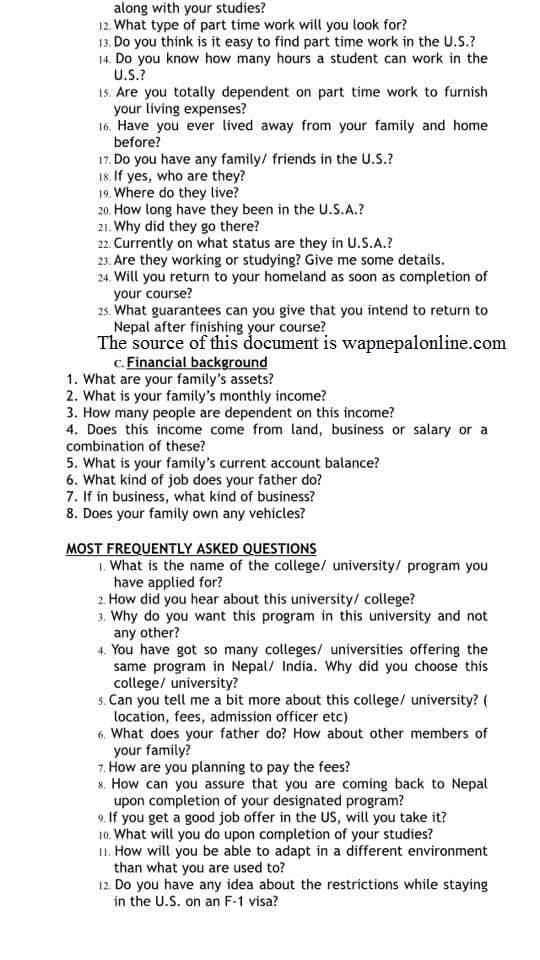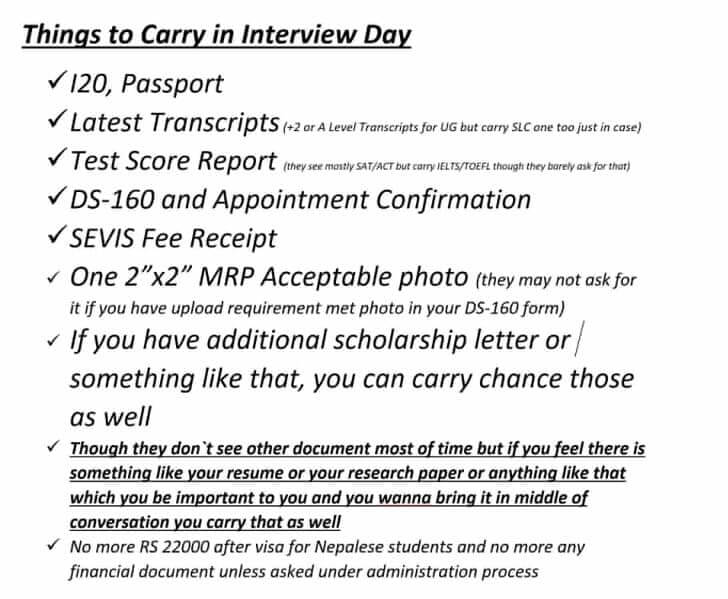USA visa interview questions are listed here. This works as a sample question for the USA visa interview. Students applying for a USA visa can prepare these sample questions. We have collected these questions from various sources.
We have categorized the possible questions into different sections: educational plan, background information, and financial background.
Table of Contents
This is not the complete list of US Embassy interview questions. Questions may vary depending on the documents you have submitted and your application.


Lastly, if you have any comments, leave them in the comment section below. Sharing is always caring. So, if you have any material then you can share it in the comment section below. If you have attended the USA visa interview, you can share your experience through the comment section below.
Things to carry during USA Visa Interview

They may ask for your photo if they find your photo not clear in the online submitted application form. So it’s better to carry them.
USA visa interview experience
These are the interview experiences posted by students who took interviews recently for USA visas.
Student visa interview 1

Program: PhD in Transportation Engineering
University: Utah State University
Date: Nov 14, 2020
Time: 13:30
Counter: 7
Me: Namaste Sir
VO: Namaste, pass me your documents
Me: (Passed documents)
VO: why this university?
Me: I haven’t searched for a university. I have searched for a prospective advisor.
VO: what are you saying?
Me: I have searched for a professor whose research interest matches mine in the field of traffic safety.
VO: (Looking MSc Transcript) What will you do after graduation?
Me: I will return to Nepal and continue my career as an academician and researcher.
VO: You are too cool. I will issue you a USA visa.
Me: Thank you, sir, have a nice day.
Student visa interview 2

Interview experience
14th June 2020
Time= 8:00
Humboldt State University, Arcata
Counter no: 6
Coa and exp about 35k
IELTS: 6.0(not asked)
No SAT, no scholarship
Academics: 62% with 2 year gap. (not asked)
I probably think I had the weirdest interview ever in USVNS history. There were many applicants before me getting yellow paper and exiting. I had a couple of problems like in the photo before an interview and the reciprocity fee afterward but who cares…
Let’s jump directly to the interview rather than bluffing.
It was about a minute and a half.
Me: good morning ma’am. How are you doing?
Vo: I am doing great. What about you?
Me: Absolutely fine.
Vo: pass me your I-20, transcript, and passport.
Me: here you go, ma’am.
Vo: so, which university are you applying to?
Me: Humboldt State University ma’am.
(she looked at my i20 2 to 3 times and started typing) then she directly skipped all the questions like (why Humboldt, how did you get to know about it, and why this major, how many universities did you apply to?).
Vo: what is your plan after graduation?
Me: (sorry, ma’am). I didn’t hear you correctly!
Vo: plans after graduation?
Me: oh, After graduation my main intention is to return to Nepal and currently I have 2 ideas either work in a government Org like (NARC) Nepal Agricultural Research Council in the fisheries research division (started typing again) to enhance (interrupted).
Vo: next?
Me: I am planning to open a recreation farm where I will be farming popular fish like .. (again interrupted).
Vo: Do you have a farm?
Me: I do. In my own city.
Vo: who’s going to sponsor you for studies?
Me: my maternal uncle.
Vo: what is his job?
Me: he’s a manager in (NEMS) north east medical services in the US. (typed, typed typed) and I was like okhooo reject garne bichar garo.
Vo: OK, how much does he earn?
Me: told. (After hearing she again asked me because she didn’t t believe me). And she gave a suspicious glance.
Vo: what does he exactly do?
Me: He manages medical records software.
(This is where I think I made an awesome move yo nagare vaye I wouldn’t have got a USA visa). I said I do have his annual income sheet. Shall I show you?
Vo: sure.
I passed my mama’s w-2 and earning summary sheet. She was pretty amazed, and she asked.
Vo: Is he married?
Me: No, he is single.
Vo: how many members are in your family?
Me: told.
Vo: Do you have any relatives in the US?
Me: No, ma’am.
Vo: I am issuing you a visa. go to the counter 11 and pay the reciprocity fee.
(I didn’t hear her correctly.)
Me: can you repeat it again? (wondering if it was a question)
Vo: go and pay; you are selected.
Me: (I was like hell yeah). thank you, ma’am. Thank you so so much (with a joyful smile). She also smiled mazza le. Eye contact was from start to end plus Idk there was a magical vibe with her.
I recommend to everybody if you have enough funds then nothing matters plus having good scores and grades might help some students but luck also decides.
Student visa interview 3

My USA visa interview was scheduled for 8:30 a.m. but as soon as I entered this officer asked my name and told me that there was an error in my DS 160 form. So I had to walk outside and ask one of the studios to fill out the form which took about half an hour. It took longer because I have been to the US 5 times already.
I am gonna skip waiting in the line part and having cute conversations with the two old women next to me.
After being ten printed I was sent to this counter which I don’t remember the number. She was a good-looking middle-aged lady with her hair right above the shoulder.
Me: hi (with a smile) and slided my documents through the glass without even her asking
Her: hi (smiling back). So what do you want to study?
Me: psychology
Her: Hmm and what do you plan to do with this degree?
Me: I wanna come back home to Nepal and give back to my community. We have a wellness center in my school that focuses on the mental and emotional well-being of students and staff which none other schools have in my town so I wanna come back and work at my school to promote being mentally and emotionally healthy.
While I was saying this, she was smiling a lot
Her: I am sorry I am smiling so much because I also went to Whitman.
Me: yes, literally we were giving each other air-five
Her: How many colleges did you apply to?
Me: only this college. I did ED2nd.
Her: I see. And you also have a full scholarship. Anyways, how did you find Whitman?
Me: So I graduated from UWC Maastricht in the Netherlands in 2018 and then went on a gap year in Senegal. A lot of US universities came to the uni fair in my school, and that’s how I found Whitman. I applied, and they accepted me with full funding.
Her: well I am very happy to issue your visa, and I hope you have a wonderful time. Please pay your fee at counter 11
Me: thank you! Have a wonderful day.
Honestly, I didn’t prepare at all for this interview even though I was a bit nervous, but I did read some of the experiences on this page, which kinda gave me an idea of what I was gonna be asked. I also didn’t focus so much on the answer that would give me anxiety because I feel like your answer after graduation doesn’t have to be solid that you will work for a specific company or organization. It can be as simple as giving back to your community. I had given multiple visa interviews for B1/B2 so That might have eased it a bit.
There might have been a bit of favoritism from the interviewer as I was going to the same college as she did, so she had given me this positive vibe since the interview started.
Student visa interview 4

VO: Good morning!
Me: Good morning, sir. How are you doing?
VO: I am doing great. Please pass me your I-20, transcript, and passport.
Me: here you go, sir (handed my documents)
VO: So, you’ve been here before?
Me: yes, sir. I was here last month, on May 17th
VO: (yesai passport paltayo thyakka Mero visa stamp bhako page parecha) oh! Ma’am you’ve been to the US before?
Me: yes, sir. I went to the US 4 years back.
VO: for what reason?
Me: I visited the States to attend my brother’s convocation, sir.
VO: Okay, you have your brother in the US? What is he doing right now?
Me: he is doing his graduate degree.
VO: In which state is he studying?
Me: sir, in Texas.
VO: okay… Where did you graduate from high school?
Me: sir, from st. Xaviers college, Maitighar.
VO: ummhmm, how did you get to know about this university?
Me: (told that I got to know abt the university from the college board and USEF ko Kura Haru Ni bhanethye and bich ma interrupt garyo)
VO: so, what made you choose this major?
Me: sir, I was inclined towards genetically disordered diseases since my early childhood when I lost my maternal grandfather, who was diagnosed with cancer at his 4th stage when the treatment was almost impossible. So, from that particular time, I felt that delayed diagnosis and the traditional techniques used for the diagnosis were the major problems faced in Nepal. So Pursuing biochemistry as my major, I want to work for the imp(interrupted)
VO: okay, okay. So, who is going to sponsor you for your studies?
Me: sir, my family will be sponsoring me.
VO: can you give some details?
Me: sure, sir. My dad is a lecturer in mechanical engineering at Pulchowk engineering college, and my mom runs a boutique shop in my hometown. Similarly, my elder brother is a civil engineer who might also sponsor me if necessary.
VO: wait, where does your dad work? Is it in Nepal?
Me: yes, sir. Pulchowk engineering college is in Lalitpur
(I don’t remember him asking about total income, hai)
VO: OK, ma’am….Khai k bhanyo tala herdai k golo golo gare jasari boldai thyo.. Mata Feri k ma golo layo bhaneko Ta VO ko signature Nai duita golo combine gare jasto raicha. Ani malai passport diyo sign gareko part dekhne gari .
So I have issued you a f1 visa. Congratulations! have a good day bhanyo
Mata khusi bhaisake thye Khai last ma namaste garera, Thank you so much, sir. Have a great day bhanera hiney.
This is a perfect preparation guide for a US Embassy interview. If you are going to apply for a student visa, this example will, of course, guide you in preparing to interview. If you are applying on a student visa and if you are a genuine student, then you will not have any problem getting a visa. USA student visa interview guide for students will help you to prepare well before the interview.
Prepare guide for US Embassy Interview
Why are you reapplying, or why did you get rejected last time?
The last interview was my first, so I got nervous and didn’t get an excellent chance to explain my cases. So, I’m reapplying.
Why the USA?
US degrees are given preference for job opportunities in Nepal as compared to any other country’s degree. This will secure my future. The syllabus and curriculum in the USA are designed according to modern standards and needs. There is a small classroom, a highly skilled and experienced professor, and a lecture with practical-based teaching helps to learn things better. So, by seeing these facilities, I chose the USA to study.
Why USA universities? Why not UK and Canadian universities?
No scholarship opportunities are available for international students in UK Canadian universities. In comparison, the tuition fees and living expenses are also very high.
Why did you choose an MBA?
First, it is related to my prior study, a Bachelor in Business Administration. Second, As you know, so much FDI and international trade is going on in Nepal, which brings me many opportunities once I have this degree from the US, Which has excellent value.
How will this course of study benefit your career and your country?
Studying for an MBA in Management and Operations has advantages for me. As you know, so many MNCs are entering Nepal, which brings me many opportunities once I have this degree from the US, Which has excellent value. Studying management and operations can be outside of MNC; various big industries in Nepal requires such human resource. Also, most Nepalese universities specialize in finance, Human Resource Management, or Marketing. So, few people here have the knowledge of management and operations. This will give me an advantage over my competitors.
Why this university?
Among the universities I applied to, this university was mainly there to reply to my email. I would like to know about the university fee structure, my scholarship chances, international students, and Nepali society. This university provides me with some scholarships, and the tuition fees and living expenses are also low compared to another university to which I’ve applied. The international admission adviser of this university is also very kind and cooperative. So, taking everything into consideration, I have chosen this university.
How can you tell me that you are returning to Nepal?
As you know, Since my childhood, my parents have been invested in my education, and I am also the only child of my parent. So, after graduation, I have got plenty of responsibility for them. And after getting a US degree, I will get a good opportunity in my country that will help to build my reputation in my society. My parents, family, property, relatives, culture, and tradition everyone has an equal part to play in my return.
Where will you stay in the USA?
I intend to stay at the accommodation provided by the university.
Tell me about your university.
My university name is Atlantis University, and it is located in Miami, Florida. It was originally established in 1905 AD. The president of the university is Dr John Jasinki. There are around 7000 students studying at my university. Among them, about 130 are Nepalese students. The student-to-teacher ratio is 21 to 1, so there will be proper interaction between teachers and students. And the international admission adviser of my university is Bianca Palacios.
Why not in Nepal?
Well, I have completed my bachelor’s in Nepal, and I have friends who have studied in the USA. And I can feel the difference in the thinking and the knowledge. I will be closer to my friends and my family if I study in Nepal. However, at this stage of my life, staying in the USA helped to make me responsible and independent. It will help to develop my personal and intellectual growth. And US degrees are given priority in every field as compared to Nepal degrees.
What will you do if I don’t issue your visa?
Well, as for the embassy requirement, I have fulfilled everything. So I hope you will issue my visa.
Why Florida?
Because my university is located in Miami, Florida, and the temperature of Miami is similar to my hometown, where I have lived most of my life. This place is safe for international students. In Miami, I will find many Nepali students, which will help me to learn and settle into a new culture easily. So, I chose Miami.
Who is your sponsor?
My father and mother and my maternal uncle are sponsors. My father is a branch manager at National Life Insurance Company and has annual earnings of around ten lakhs rupees, and my maternal uncle has a medical shop that has annual earnings of around rs 25 lakhs. And my mother is a school in-charge who has an annual earning of around rs 1 lakhs 80 thousand.
Whom do you share your room/apartment with? Nepalese or international students?
Yeh! I would prefer international American students to share my room; it will provide me with a great opportunity to learn about culture and tradition.
How long will you stay in the USA?
I intend to stay until my studies last. It is 36 months for my course of choice.
How did you find this institution?
I used different methods to find this university. By taking advice from senior. By visiting different websites.By taking advice from a guide counselor. My personal search corresponded to an international admission advisor.
Do you have any relatives in the USA?
No, till now nobody has visited the USA from my family and my relatives. I hope I will be the first person to visit the USA.
Whom do you correspond with?
Bianca Palacios, my university’s international advisor.
Can you tell me about the currency of the USA?
The currency of the USA is the US dollar. It is the most popular and globally accepted currency in the world.
What did you know about the USA? How did you apply? How did you get your I-20?
Yes, I searched for my university, and then I went to the USEF to test my academic character. Then, I filled out an online form and sent my document to the university via DHL, and after a few days, they provided me an email that I was accepted by the university. A few days later, they sent my I-20 to my home address.
How many universities did you apply to?
Yes, I have applied to 3 universities. First is Warner University. The second one is Webber International University, and finally, I was admitted to Atlantis University.
What do you do on holiday?
Well, during the holidays time, I will go through my course of study, and I will enjoy my time with new friends.
What are your qualities so I can issue you a visa?
Well, my parents are sponsoring my education, and they have a proper source of income, property, and bank balance. I am a genuine applicant, and my academic background is also good. I have an affordable I-20 from a well-recognized university. And as for the embassy requirement, I have fulfilled all things. So I hope I am suitable for entry.
What is your future plan?
Well, after completing my education, I will return back to my country. And I would like to work as a Head of the Operations Department.
What will you do?
US law doesn’t permit international students to work during study periods. I will do it within the rules and regulations. After I complete my course and such opportunities, to some extent, I do it so that I can utilize those skills and experiences when I return to Nepal.
Do you have any education gap? If yes, what did you do in that period?
Yes, I have a 2-year education gap, and I have utilized those gap periods by doing computer courses from 3 3-star DPT training centers, practicing TOEFL, and searching and applying for USA universities.
What is your academic background?
I have completed my Bachelor in Management with first-division marks.
Can you tell me how you transfer money from Nepal?
Yeh! After I get a visa, I will get a no-objections letter from the Ministry of Education. Then, I will go to the bank and utilize different methods to send money from Nepal, like Bank overdraft, Wire transfer, Mobile cheque, etc.
How will you find your college after landing in the USA?
Before my departure, I will send my traveling itinerary to my international admission advisor, and she will manage to pick me up.
